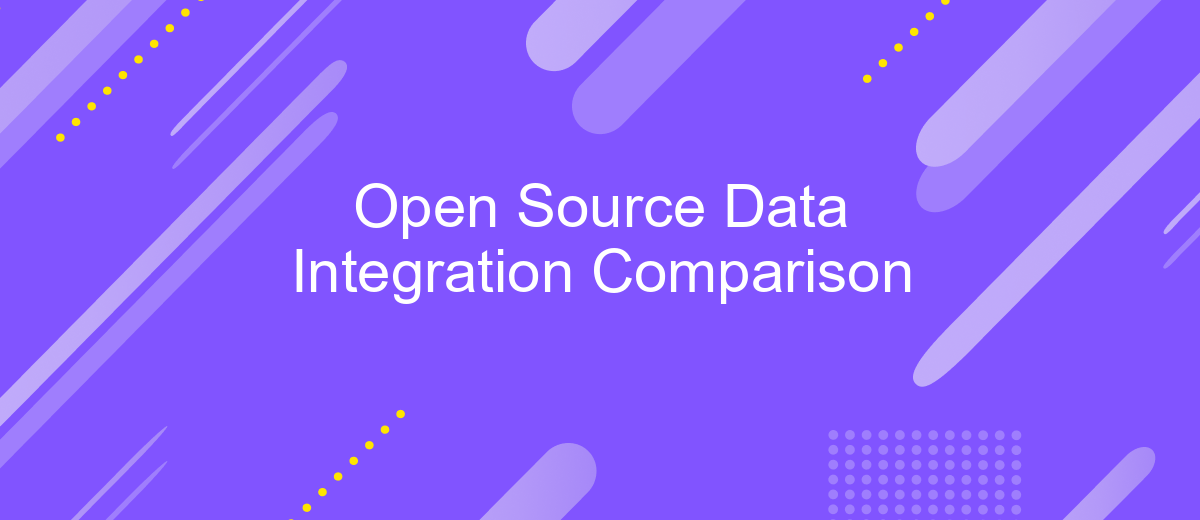Open Source Data Integration Comparison
In today's data-driven world, integrating diverse data sources efficiently is crucial for informed decision-making. Open source data integration tools offer cost-effective and flexible solutions for businesses of all sizes. This article provides a comparative analysis of popular open source data integration tools, highlighting their features, strengths, and potential drawbacks to help you choose the best fit for your organization's needs.
Introduction
Open source data integration tools have become increasingly popular in recent years, offering a cost-effective and flexible alternative to proprietary solutions. These tools enable organizations to seamlessly connect, transform, and manage data from various sources, ensuring that information flows smoothly across different systems. As the demand for data-driven decision-making grows, choosing the right data integration tool is crucial for achieving operational efficiency and business success.
- Cost-effectiveness: Open source tools are generally free, reducing the financial burden on organizations.
- Flexibility: Open source solutions can be customized to meet specific business needs.
- Community Support: A strong community of developers contributes to continuous improvement and troubleshooting.
- Scalability: These tools can be scaled to handle large volumes of data as the organization grows.
This article will provide a comprehensive comparison of various open source data integration tools, examining their features, advantages, and limitations. By understanding the strengths and weaknesses of each tool, organizations can make informed decisions that align with their data integration needs and strategic goals.
Platform Comparison

When comparing open source data integration platforms, several key factors come into play, including ease of use, scalability, and community support. Talend Open Studio, for example, offers a user-friendly interface and extensive documentation, making it accessible for both beginners and experienced users. On the other hand, Apache Nifi provides robust scalability and real-time data processing capabilities, which are essential for handling large volumes of data efficiently. Both platforms benefit from active community support, ensuring that users can find solutions to their issues and share best practices.
Another critical aspect to consider is the availability of pre-built connectors and ease of integration with various data sources. Platforms like ApiX-Drive excel in this area by offering a wide range of pre-configured integrations and a user-friendly interface that simplifies the setup process. This can significantly reduce the time and effort required to connect different data sources, making it an attractive option for businesses looking to streamline their data workflows. Ultimately, the choice of platform will depend on the specific needs and priorities of your organization.
Feature Comparison

When comparing open source data integration tools, several key features stand out that can significantly impact your choice. These features determine the efficiency, scalability, and flexibility of the integration process, making it essential to evaluate them carefully.
- Data Connectivity: The ability to connect to various data sources, including databases, cloud services, and APIs.
- Transformation Capabilities: Tools should support a wide range of data transformation functions, including filtering, aggregating, and joining datasets.
- Scalability: The tool's ability to handle increasing amounts of data and concurrent processes without performance degradation.
- Ease of Use: User-friendly interfaces and extensive documentation can significantly reduce the learning curve.
- Community Support: Active communities and regular updates can provide valuable support and ensure the tool's longevity.
These features are crucial in determining the best open source data integration tool for your needs. By carefully evaluating each tool based on these criteria, you can ensure a more efficient and effective data integration process.
Case Studies and Success Stories

Open source data integration tools have been instrumental in transforming businesses across various industries. One notable example is a mid-sized retail company that leveraged Talend to streamline its data processes. By integrating disparate data sources, the company achieved real-time analytics, which significantly improved its inventory management and customer experience.
Another success story comes from a healthcare provider that utilized Apache Nifi to handle sensitive patient data. The tool's robust security features and seamless integration capabilities allowed the provider to comply with stringent regulations while enhancing data accessibility for medical staff.
- A financial institution used Pentaho to consolidate financial reports, reducing manual errors and accelerating decision-making.
- A logistics company adopted Apache Camel to automate data workflows, resulting in a 30% increase in operational efficiency.
- An educational institution implemented Airbyte to synchronize student data across multiple platforms, enhancing administrative efficiency.
These case studies highlight the versatility and effectiveness of open source data integration tools. Organizations of all sizes and sectors are leveraging these solutions to address complex data challenges, driving innovation and operational excellence.


Conclusion
In conclusion, the comparison of open source data integration tools highlights their diverse capabilities and flexibility in handling various data integration needs. These tools offer cost-effective solutions with a strong community support, making them suitable for organizations looking to streamline their data processes without significant financial investment. Each tool has its strengths and weaknesses, and the choice largely depends on specific requirements such as ease of use, scalability, and the complexity of the integration tasks.
Additionally, services like ApiX-Drive play a crucial role in simplifying the integration process by providing user-friendly interfaces and pre-built connectors for a wide range of applications. This can significantly reduce the time and effort required to set up integrations, allowing businesses to focus on leveraging their data for strategic decision-making. Therefore, combining open source tools with services like ApiX-Drive can offer a balanced approach, maximizing efficiency while maintaining the flexibility and cost advantages of open source solutions.
FAQ
What is Open Source Data Integration?
What are some popular Open Source Data Integration tools?
How do Open Source Data Integration tools compare to proprietary solutions?
What are the benefits of using Open Source Data Integration tools?
How can I automate and set up integrations using Open Source Data Integration tools?
Apix-Drive is a simple and efficient system connector that will help you automate routine tasks and optimize business processes. You can save time and money, direct these resources to more important purposes. Test ApiX-Drive and make sure that this tool will relieve your employees and after 5 minutes of settings your business will start working faster.

